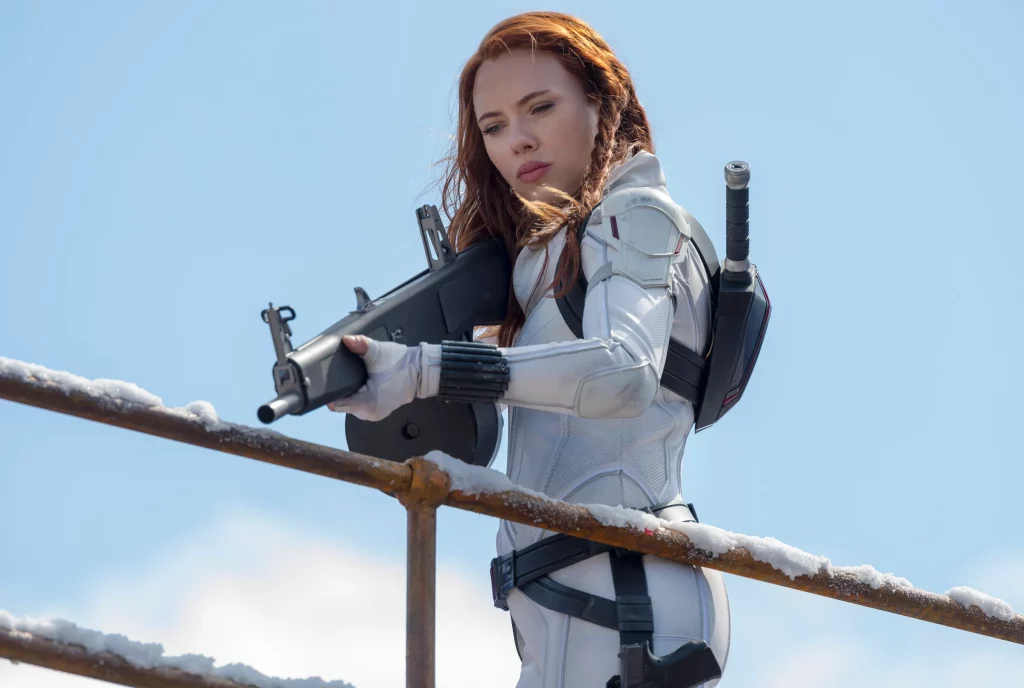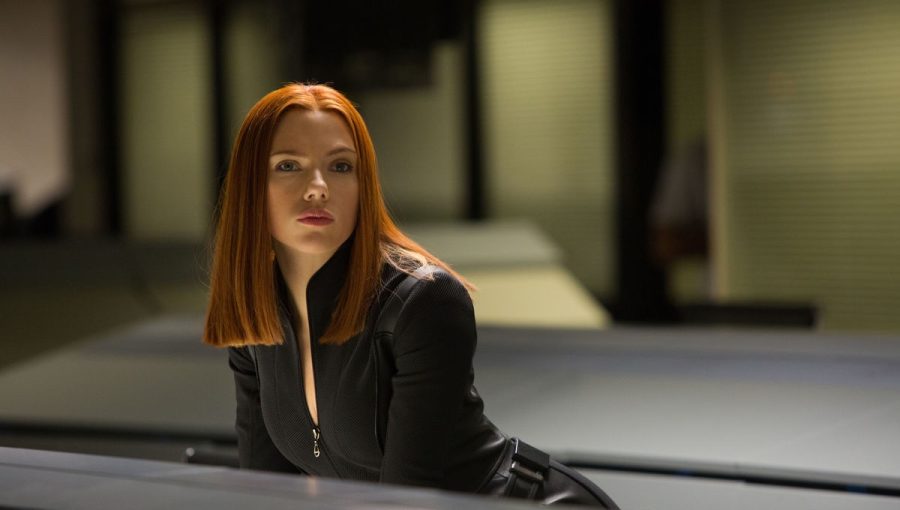The term ‘Male Gaze‘ was coined by Laura Mulvey in her 1975 essay ‘Visual Pleasures and Narrative Cinema’ which suggested that female characters in cinematic narratives are there to satisfy the visual pleasure of the male characters and audience. This reduces the female character’s wants, beliefs and storyline to factors that are less important compared to her looks, perming for objectification and hyper-sexualisation to take place, as well as re-enforcing patriarchal beliefs. It is argued that women take on passive roles in the story, letting events happen to them, whilst male characters have agency to progress the narrative further.
Iron Man 2(2010) introduces ‘Black Widow’ (otherwise known as Natasha Romanoff and played by Scarlett Johansson) into the MCU. From the first introduction, Natasha’s character is subject to the scrutiny of the Male Gaze.
The camera work in this first meeting scene with Tony Stark and Hogan draws attention to Natasha’s body in fragments and zooms in on movements that can be perceived as hyper-sexual – for example, when Romanoff gets into the rink the chosen camera angle allows audiences to observe her hips as she bends and then gets back up, where the camera once again, lingers on her, but this time on her face.
When characters, like Stark and Hogan, look at Natasha, it allows the audience to observe her in the same way, because they are experiencing the scene through the lens of the male characters there, who are clearly infatuated with Romanoff (Maloney, 2016).
Tony: Did you model in Tokyo? ‘Cause she modeled in Tokyo.
Pepper: Well …
Tony: I need her. She’s got everything that I need.
Natasha: Will that be all, Mr. Stark?
Tony: No.
Pepper: Yes, that will be all, Ms Rushman [a.k.a. Natasha]. Thank you very much. [Natasha leaves.]
Tony [to Peper]: I want one.
Pepper: No.
Iron Man 2
In contradication to my prior statement that the female heroine’s past becomes second to her apperance, the fact that Natasha modeled before, as identified by Stark, is quite important as it re-enforces her sex appeal to audiences. Ironically that is as much as the male lead is interested in knowing about her before he proceeds to objectify her by saying “I want one” (Kilian, 2022).
Despite the harsh sexualisation of her character through camera work and sultry outfits, Black Widow challenges the Male Gaze lens and the patriarchal beliefs it carries with it. She displays execelent fighting abilities in the boxing rink and later when fighting a group of men. In the first meeting scene, Hogan dismisses Natasha’s ‘experience’ with boxing to probable activities girls would complete in school or dable in hobbies – it never crosses his mind that she might be a very skilled fighter, arguably due to the fact that is an attractive woman, and those two cannot co-exist in the ‘Male Gaze’.
How has this changed?

In newer MCU movies, like Black Widow (2021), Natasha has been given an expanded upon backstory, and no love interest, making her the active agent in her story, and invites viewers to engage with her as a character rather than stare at her like good looking plot decoration (Dockterman, 2021). Arguably, having a female director, Cate Shortland, in Black Widow has made these differences possible due to her being able to implement female wants and needs into the story (Cheung, 2021), as this was the case in cinema 50 years ago, when male production teams would craft bland female characters based on their desires.
Image from ‘Black Widow (2021)’
References
Cheung, K. (2021) Scarlett Johansson says Black Widow was hypersexualized when first entering the MCU, salon. Available at: https://www.salon.com/2021/06/18/scarlett-johansson-black-widow-sexualized/ (Accessed: 02 December 2024).
Dockterman, E. (2021). Black Widow began as a sexist stereotype. More than a decade later, Scarlett Johansson is reclaiming her story. Time, Inc. Available at: https://time.com/6077666/black-widow-scarlett-johansson/(open in a new window)
Killian, K. D. (2022) ‘An Analysis of Black Widow (2021): Marvel’s Most Feminist Film Features Powerful Sisters and an Attenuated Male Gaze’, Journal of Feminist Family Therapy, 35(1), pp. 106–113. doi: 10.1080/08952833.2022.2139926.
Maloney, L. (2016) Black widow’s subversion of the male gaze, ENGL 359. Available at: https://xuengl359.wordpress.com/home/final-projects/black-widows-subversion-of-the-male-gaze/ (Accessed: 02 December 2024).
Mulvey, L. (1975) Visual Pleasure and Narrative Cinema. Available at: https://www.asu.edu/courses/fms504/total-readings/mulvey-visualpleasure.pdf (Accessed: 02 December 2024).


I loved the example you used! It was very insightful to highlight the differences between the older and newer MCU movies and state that in the newer one, there was a female director which explains why Black Widow was not seen through the male gaze but portrayed as an active character that is not only here to please a male audience. Great blog!
Your article is very interesting. I especially like your comparison between Iron Man 2 and Black Widow, which clearly shows the transformation of the Black Widow character. At the beginning, it really feels like she exists more as a ‘flower vase’ character, to be appreciated by male characters and the audience in a ‘staring’ way. The line ‘I want one’ you mentioned is really infuriating, but it also truly reflects the existence of this male perspective at the time.
However, I think the changes you mentioned in ‘Black Widow’ (2021) are particularly promising and inspiring. There is no love line, and it is more about the unfolding of her own story. This really makes people see her charm as a complete character. Especially with the participation of a female director, the characterisation has indeed added a lot of nuance.
Your analysis has made me think more about the character of Black Widow, especially about the influence of the gender perspective. I look forward to seeing more unconventional female characters like Black Widow in the future!
Your post raises some fantastic points regarding the male gaze in the framing of Black Widow, but I do question at what times her character challenges this narrative. Moments in Captain America: Winter Soldier and her solo film put more emphasis on her intelligence and moral complexity rather than her physical frame. Does this duality play a role, where the male gaze is present but perhaps not definitive?
Hello dear, I really resonate with all the blogs you post! I just re-watched the Marvel movie a few days ago, and when I wasn’t exposed to the concepts of “male coagulation” and “women’s rights” a few years ago, I was totally fine with the movie, but when I re-watched it, the first thought that came to mind was “Why is she wearing high heels as a professional assassin”. This is a clear case of objectification of women. There is no denying that Black Widow has a charismatic personality, but in the first few movies she was portrayed as “soulless”. It’s the sexy femme fatale model for men. In the hands of a female director, she is the real Black Widow.😎